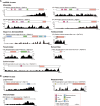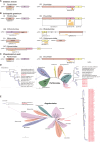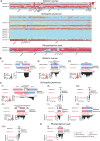Diversity and evolution analysis of RNA viruses in three wheat aphid species
- PMID: 40197145
- PMCID: PMC11978097
- DOI: 10.1186/s12864-025-11512-1
Diversity and evolution analysis of RNA viruses in three wheat aphid species
Abstract
Background: Although advances in metagenomics, viral diversity and non-retroviral endogenous viral elements (EVEs) in wheat aphids remain underexplored. By analyzing 470 publicly available datasets and one laboratory-generated transcriptome, the RNA virome and EVEs in the genomes of Sitobion avenae, Schizaphis graminum, and Rhopalosiphum padi were systematically investigated.
Results: We identified 43 RNA viruses, including 12 novel and 31 known RNA viruses. These viruses were widely distributed and abundant in different geographic populations of three wheat aphid species. +ssRNA viruses were the dominant type of aphid viruses. Besides, 90 EVEs were discovered in the genomes of three aphid species. In addition, the EVEs exhibit potential domestication and novel functional roles within aphid genomes.
Conclusions: This study expands the understanding of RNA virus diversity in aphids and provides valuable insights into the potential functions of EVEs in virus-host coevolution.
Keywords: Endogenous viral elements; Insect-specific viruses; RNA virome; Wheat aphids.
© 2025. The Author(s).
Conflict of interest statement
Declarations. Ethics approval and consent to participate: Not applicable. Consent for publication: Not applicable. Competing interests: The authors declare no competing interests. Disclosure: We declare that we do not have any commercial or associative interest representing a conflict of interest in connection with the work submitted. Clinical trial: Not applicable.
Figures





Similar articles
-
Elevated CO2 changes interspecific competition among three species of wheat aphids: Sitobion avenae, Rhopalosiphum padi, and Schizaphis graminum.Environ Entomol. 2009 Feb;38(1):26-34. doi: 10.1603/022.038.0105. Environ Entomol. 2009. PMID: 19791595
-
The impact of transgenic wheat expressing GNA (snowdrop lectin) on the aphids Sitobion avenae, Schizaphis graminum, and Rhopalosiphum padi.Environ Entomol. 2011 Jun;40(3):743-8. doi: 10.1603/EN10261. Environ Entomol. 2011. PMID: 22251654
-
Cereal aphids differently affect benzoxazinoid levels in durum wheat.PLoS One. 2018 Dec 3;13(12):e0208103. doi: 10.1371/journal.pone.0208103. eCollection 2018. PLoS One. 2018. PMID: 30507950 Free PMC article.
-
Paleovirology of bornaviruses: What can be learned from molecular fossils of bornaviruses.Virus Res. 2019 Mar;262:2-9. doi: 10.1016/j.virusres.2018.04.006. Epub 2018 Apr 6. Virus Res. 2019. PMID: 29630909 Review.
-
The Potential Role of Endogenous Viral Elements in the Evolution of Bats as Reservoirs for Zoonotic Viruses.Annu Rev Virol. 2020 Sep 29;7(1):103-119. doi: 10.1146/annurev-virology-092818-015613. Epub 2020 May 20. Annu Rev Virol. 2020. PMID: 32432980 Review.
References
-
- Jin Z, Wang X, Chang S, Zhou G. The complete nucleotide sequence and its organization of the genome of Barley yellow dwarf virus-GAV. Sci China C Life Sci. 2004;47(2):175–182. - PubMed
-
- Zhang W, Cheng Z, Xu L, Wu M, Waterhouse P, Zhou G, et al. The complete nucleotide sequence of the barley yellow dwarf GPV isolate from China shows that it is a new member of the genus Polerovirus. Arch Virol. 2009;154(7):1125–1128. - PubMed
MeSH terms
Grants and funding
LinkOut - more resources
Full Text Sources

